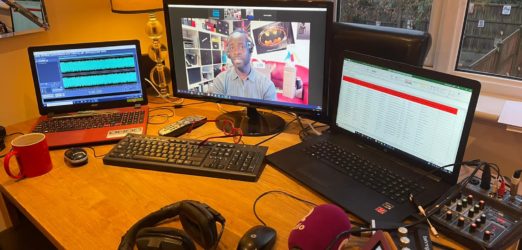They say that good comes out of bad. With the pandemic and broadcast PR industry, that good is the boom in popularity of remote interviews.
In pre-pandemic times, we would always advise clients to conduct interviews (both TV and radio) from a broadcast studio. After all, they offered fantastic sound quality which is essential to broadcasters. This meant that radio stations preferred to take interviews via studio ISDN lines rather than a landline or mobile.
Meanwhile, in TV, only a major breaking story would convince producers to agree to anything less than an in-person interview.
Covid-19 has changed all of this. We wanted to continue providing broadcast PR campaigns throughout the pandemic but had to work out a way of delivering them remotely.
With the help of software such as Zoom, we slipped into facilitating remote interviews from a variety of locations. Bedrooms, kitchen tables and lofts, you name it, we (and our spokespeople) have been there. However, this wasn’t a quick fix, this would become the new way of working.
Benefits of the Remote Broadcast PR Studio
90% of our broadcast PR sessions are now carried out remotely and the vast majority of our clients prefer it. Software has now become so advanced that, most of the time, there is no longer a drop in sound quality.
Sure, there can be occasional glitches, but that happened with ISDN technology too. And, on the upside, radio shows and TV programmes have been able to access spokespeople who wouldn’t otherwise have been able to travel to a studio. Plus, as we all re-assess how we want to work in the future, the convenience factor is clear to see.
Spokespeople can broadcast from the comfort of their homes. Clients no longer need to take a day out of their schedule to travel to a studio. And broadcasters aren’t using up dwindling resources to accommodate guests.
A New Era for Broadcasters
Such is the popularity of the remote broadcast PR studio some broadcasters have already made the leap and upgraded their technology to accommodate them. And maybe it’s just as well, because BT was the sole provider of ISDN lines across the country, and they had already announced they were stopping taking new orders amid a phase-out of the technology.
Sure, there are still benefits to sitting on the sofa on BBC Breakfast, but the COVID-19 pandemic has been the kick that broadcasters needed to truly utilise new technologies. Leading the way are Sky News and the BBC who have confirmed they will continue to use Zoom for interviews going forward.
Top Tips for Remote Broadcast PR Sessions
- We have a technical rehearsal at least a day before the campaign date. This is to carry out vital checks on the equipment the spokesperson will use and to ensure the acoustics and sound quality of the room are of broadcast standard.
- An internet diagnostic test ensures the connection is strong enough for the spokesperson to facilitate broadcast PR interviews. This will avoid the internet cutting out halfway through an interview.
- For TV, we work with the client to position the spokesperson with the perfect backdrop to accompany the story. This may involve an outside location to increase chances of landing TV coverage but it could be from their home or office too.
- We have a briefing with the client and spokespeople prior to the broadcast PR campaign day. Here, we ensure the spokespeople understand what key messages need to be delivered in interviews.
- We provide all clients with a link to join the remote radio studio so they can listen in and provide any feedback if required. This gives you control but also the flexibility to get on with other work if needed.
How Can Shout Communications Help with Your Broadcast PR Campaign?
Shout! Communications is a team of broadcast PR professionals with decades of experience, creating and leading broadcast content for national radio and TV. We know what broadcasters want from a remote Broadcast PR interview, and more importantly, what they don’t want. To learn more about how we can help you with radio and TV media relations, contact us today.



